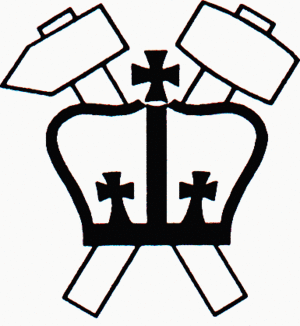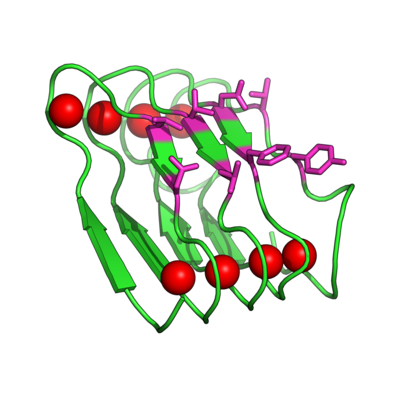Banta:Gels: Difference between revisions
Scott Banta (talk | contribs) No edit summary |
Scott Banta (talk | contribs) No edit summary |
||
| Line 1: | Line 1: | ||
{{Template:Banta_Lab}} | {{Template:Banta_Lab}} | ||
[[Image:BetaRoll.jpg|thumb|400px|right|Crystal structure of a folded Beta Roll domain where the red spheres indicate the bound Ca+2 ions and the purple resides are randomized for molecular recognition (Dooley, Kim, Lu, Tu, and Banta, 2012 Biomacromolecules).]] | |||
'''Bifunctional Proteinaceous Hydrogels for Bioelectrocatalysis''' | '''Bifunctional Proteinaceous Hydrogels for Bioelectrocatalysis''' | ||
Revision as of 09:50, 17 July 2014

Banta Lab
Protein and Metabolic Engineering
| Home | Lab Members | Publications | Research Interests | Courses | Pictures | Positions Available |

Bifunctional Proteinaceous Hydrogels for Bioelectrocatalysis
Self-assembly is an essential process for all forms of life. For example, proteins spontaneously fold into well-defined 3-dimensional structures, and cellular organelles form that spatially segregate diverse cellular processes. As engineers aim to create new devices and systems at ever decreasing size scales, self-assembly processes become increasingly attractive techniques.
We are interested in using protein self-assembly in bioelectrocatalytic applications including biofuel cells and biosensors. In these devices it is critical to have a high loading of enzymes on the electrode and to address transport issues including electrical communication with the electrode and substrate and product transport to and from the enzyme.
We have developed a technology where self-assembly domains are genetically appended to globular proteins and this enables the proteins to self-assemble into bifunctional hydrogels. We have performed this modification on over a dozen different proteins and in all cases the proteins retain their biological function (activity) while gaining the ability to form a biomaterial. We have demonstrated the use of these materials as electrode modifications for biofuel cells and biosensors. We are continuing to develop this approach to make catalytic biomaterials for additional applications.
Related Publications
- Lu HD, Wheeldon IR, and Banta S. Catalytic biomaterials: engineering organophosphate hydrolase to form self-assembling enzymatic hydrogels. Protein Eng Des Sel. 2010 Jul;23(7):559-66. DOI:10.1093/protein/gzq026 |
- Banta S, Wheeldon IR, and Blenner M. Protein engineering in the development of functional hydrogels. Annu Rev Biomed Eng. 2010 Aug 15;12:167-86. DOI:10.1146/annurev-bioeng-070909-105334 |
- Wheeldon IR, Campbell E, and Banta S. A chimeric fusion protein engineered with disparate functionalities-enzymatic activity and self-assembly. J Mol Biol. 2009 Sep 11;392(1):129-42. DOI:10.1016/j.jmb.2009.06.075 |
- Wheeldon IR, Gallaway JW, Barton SC, and Banta S. Bioelectrocatalytic hydrogels from electron-conducting metallopolypeptides coassembled with bifunctional enzymatic building blocks. Proc Natl Acad Sci U S A. 2008 Oct 7;105(40):15275-80. DOI:10.1073/pnas.0805249105 |
- Gallaway J, Wheeldon I, Rincon R, Atanassov P, Banta S, and Barton SC. Oxygen-reducing enzyme cathodes produced from SLAC, a small laccase from Streptomyces coelicolor. Biosens Bioelectron. 2008 Mar 14;23(8):1229-35. DOI:10.1016/j.bios.2007.11.004 |
- Wheeldon IR, Barton SC, and Banta S. Bioactive proteinaceous hydrogels from designed bifunctional building blocks. Biomacromolecules. 2007 Oct;8(10):2990-4. DOI:10.1021/bm700858p |